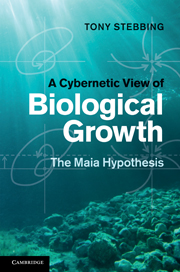Book contents
- Frontmatter
- Contents
- Foreword by Ernest Naylor
- Preface: ‘A fragment of a possible world’
- Acknowledgements
- 1 Introduction
- 2 Growth unlimited: blooms, swarms and plagues
- 3 Self-regulating systems: from machines to humans
- 4 The wealth of homeodynamic responses
- 5 A cybernetic approach to growth analysis
- 6 A control mechanism for Maia
- 7 The three levels of adaptation
- 8 Population growth and its control
- 9 Hierarchy: a controlled harmony
- 10 History of hormesis and links to homeopathy
- 11 Maian mechanisms for hormesis and catch-up growth
- 12 Cellular growth control and cancer
- 13 Human overpopulation
- 14 Our finite Earth
- 15 The Maia hypothesis and anagenesis
- Glossary
- Further reading
- References
- Index
Foreword by Ernest Naylor
Published online by Cambridge University Press: 10 January 2011
- Frontmatter
- Contents
- Foreword by Ernest Naylor
- Preface: ‘A fragment of a possible world’
- Acknowledgements
- 1 Introduction
- 2 Growth unlimited: blooms, swarms and plagues
- 3 Self-regulating systems: from machines to humans
- 4 The wealth of homeodynamic responses
- 5 A cybernetic approach to growth analysis
- 6 A control mechanism for Maia
- 7 The three levels of adaptation
- 8 Population growth and its control
- 9 Hierarchy: a controlled harmony
- 10 History of hormesis and links to homeopathy
- 11 Maian mechanisms for hormesis and catch-up growth
- 12 Cellular growth control and cancer
- 13 Human overpopulation
- 14 Our finite Earth
- 15 The Maia hypothesis and anagenesis
- Glossary
- Further reading
- References
- Index
Summary
Compared with the high-profile discoveries of molecular genetics concerning individual genes and their specific expression at the tissue and organ level, studies of general patterns of growth in living organisms often receive less public attention in the media. Yet an understanding of the processes of biological growth at the level of the individual and in populations of organisms is key to human survival. Uncontrolled growth is a feature of human cancer cells which prejudices survival at the level of the individual, while unchecked growth of global human population density has to be considered against a background of finite limitations of planetary living space and natural resources. Indeed, this book begins with the premise that the basis of all biological growth is exponential, with an inherent tendency for constant doubling with time. A priori, therefore, it is argued that there would be evolutionary adaptive advantage to be gained by the acquisition of mechanisms which induce self-limitation of growth processes and therefore enhance the chances of survival of individuals and populations of organisms, including humans.
The author's interest in these phenomena started when he was studying the biological effects of toxic chemicals discharged into the sea. In laboratory experiments, the growth of simple marine organisms such as hydroid coelenterates was tested in response to the application of various toxins. As expected, growth of the test organisms was inhibited following exposure to high concentrations of chemical toxins such as copper.
- Type
- Chapter
- Information
- A Cybernetic View of Biological GrowthThe Maia Hypothesis, pp. vii - viiiPublisher: Cambridge University PressPrint publication year: 2010



